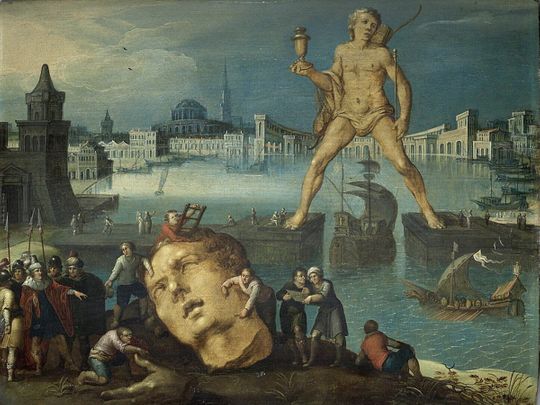
For over 50 years, a massive bronze statue of a man towered over the Greek city of Rhodes, welcoming people to its shores and reminding them of the triumph of the city over invaders.
Click start to play today’s Spell It, where you can find the “Colossus” of Rhodes.
As one of the seven ancient wonders of the world, the 108-foot bronze statue left a strong impression on the world’s collective memory. It was erected as a message of hope and victory, and here is the story behind it.
In 305BC, the Greek island of Rhodes was a thriving port city. Its fortunes drew the attention of Macedonian king Antigonus I, a successor of Alexander the Great. He wasted no time in sending his son Demetrius I Poliorcetes to attack and seize the city.
Demetrius I was known as “the besieger of cities”; he naturally thought he would be able to capture Rhodes in no time. But after a costly 12-month campaign, he had to abandon his efforts and return, to the immense joy of Rhodes’ citizens.
To announce their victory and celebrate, the Rhodians erected a statue of the sun deity Helios. Since Demetrius I had left behind many military materials, they were able to sell them off to pay for the expensive project. Greek sculptor Chares of Lindos got to work in 292BC.
Over a period of 12 years, the Colossus of Rhodes slowly took shape. The statue was built with an iron frame, like a skeleton, over which, the Rhodians placed sculpted brass plates resembling muscles and skin. Historians believe that contrary to depictions of the statue in various artworks, the Colossus didn’t stand over the bay entrance, with a foot on each end. Instead, the bronze statue stood on a base of white marble, its feet together, likely with an arm raised. Its resemblance to New York's Statue of Liberty is why the latter is often referred to as the "modern Colossus".
By 280BC, the 108-foot Rhodian statue stood tall, its bronze plates shining in the sun. It lasted till 226BC, when a thunderous earthquake snapped the Colossus at its knees and brought it tumbling down. In the seventh century AD, Arabs conquered Rhodes and dismantled the remains of the statue. Its parts were sold as scrap metal, and it apparently took 900 camels to carry the material away.
Though attempts and plans have been made to rebuild the Colossus – the most recent being in 2015 – nothing has borne fruit, so far.
Perhaps it’s destined to remain a wonder for the history books, a throwback to the glory days of a great, ancient civilisation.
What do you think? Play today's Spell It and tell us at games@gulfnews.com.






